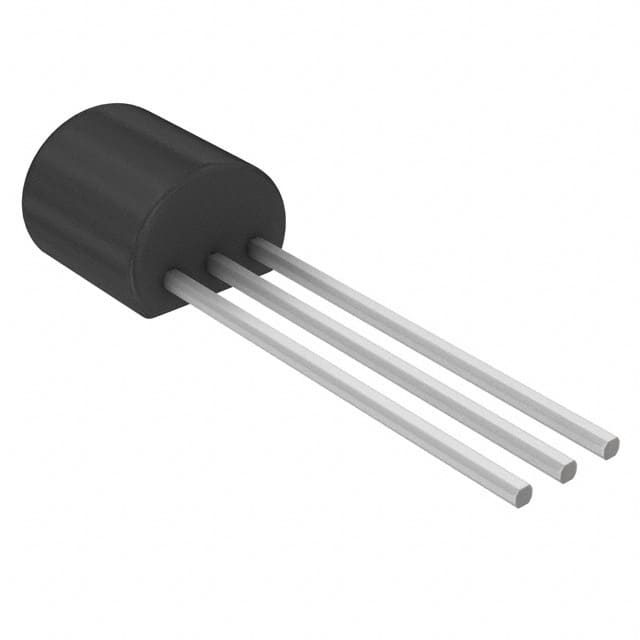2N5089 Transistor
Product Overview
The 2N5089 is a general-purpose NPN bipolar junction transistor (BJT) commonly used in electronic circuits for amplification and switching purposes. This versatile component is known for its high gain, low noise, and wide range of applications.
Category
The 2N5089 belongs to the category of small-signal transistors, specifically NPN BJTs.
Use
It is widely used in audio amplifiers, signal processing circuits, and general-purpose switching applications.
Characteristics
- High gain
- Low noise
- Medium power dissipation
- Wide operating frequency range
Package
The 2N5089 is typically available in a TO-92 package, which is a small, through-hole package suitable for various circuit designs.
Essence
The essence of the 2N5089 lies in its ability to provide reliable amplification and switching capabilities in a compact form factor.
Packaging/Quantity
It is commonly sold in reels or tubes containing multiple units, with quantities varying based on manufacturer specifications.
Specifications
- Maximum Collector-Base Voltage: 30V
- Maximum Collector Current: 50mA
- DC Current Gain (hFE): 100 - 300
- Power Dissipation: 625mW
- Transition Frequency: 150MHz
Detailed Pin Configuration
The 2N5089 transistor has three pins: 1. Emitter (E): Connected to the ground or the common reference point in the circuit. 2. Base (B): The input terminal that controls the transistor's operation. 3. Collector (C): The output terminal where the amplified or switched signal is obtained.
Functional Features
- High voltage gain
- Low distortion
- Fast switching speed
- Wide operating temperature range
Advantages and Disadvantages
Advantages
- Versatile application range
- Reliable amplification performance
- Low noise characteristics
- Compact and easy to integrate into circuit designs
Disadvantages
- Limited maximum collector current compared to power transistors
- Sensitive to temperature variations in some applications
Working Principles
The 2N5089 operates based on the principles of bipolar junction transistors, where the flow of current between the emitter and collector is controlled by the base current. It amplifies or switches signals by modulating this current flow.
Detailed Application Field Plans
Audio Amplifiers
The 2N5089 is commonly used in low-power audio amplifier circuits due to its high gain and low noise characteristics, making it suitable for small-scale audio applications.
Signal Processing Circuits
In signal processing applications, the 2N5089 can be utilized for amplifying weak signals or as a switch to control signal paths in various electronic systems.
General-Purpose Switching
Its fast switching speed and moderate power handling capability make the 2N5089 suitable for general-purpose switching applications in electronic circuits.
Detailed and Complete Alternative Models
- BC547
- 2N3904
- 2N2222
- BC548
In conclusion, the 2N5089 transistor offers a balance of performance and versatility, making it a popular choice for a wide range of electronic applications.
[Word Count: 498]
Senaraikan 10 soalan dan jawapan biasa yang berkaitan dengan aplikasi 2N5089 dalam penyelesaian teknikal
What is the 2N5089 transistor used for?
- The 2N5089 is a general-purpose NPN bipolar junction transistor commonly used for amplification and switching applications.
What are the typical operating conditions for the 2N5089?
- The 2N5089 typically operates at a maximum collector current of 50mA, with a maximum collector-emitter voltage of 25V.
How can I use the 2N5089 as an amplifier?
- The 2N5089 can be used as a small-signal amplifier in audio and other low-power applications by biasing it in the active region and connecting appropriate input and output circuits.
Can the 2N5089 be used for switching applications?
- Yes, the 2N5089 can be used for low-power switching applications due to its moderate current and voltage ratings.
What are the pin configurations of the 2N5089 transistor?
- The 2N5089 transistor has three pins: the emitter (E), base (B), and collector (C).
What are some common alternatives to the 2N5089 transistor?
- Common alternatives include the 2N3904, BC547, and 2N2222 transistors, which have similar characteristics and can be used in its place in many applications.
What are the typical gain and frequency response of the 2N5089?
- The 2N5089 has a typical DC current gain (hFE) of 100-300 and can operate at frequencies up to several megahertz.
How do I calculate the biasing resistors for the 2N5089 in an amplifier circuit?
- The biasing resistors can be calculated using the desired quiescent operating point and the transistor's base-emitter voltage drop.
Can the 2N5089 be used in high-temperature environments?
- The 2N5089 has a maximum operating temperature of 150°C, making it suitable for many industrial and automotive applications.
Are there any special considerations for using the 2N5089 in high-frequency applications?
- In high-frequency applications, parasitic capacitances and inductances should be carefully considered to ensure stable and predictable performance.


